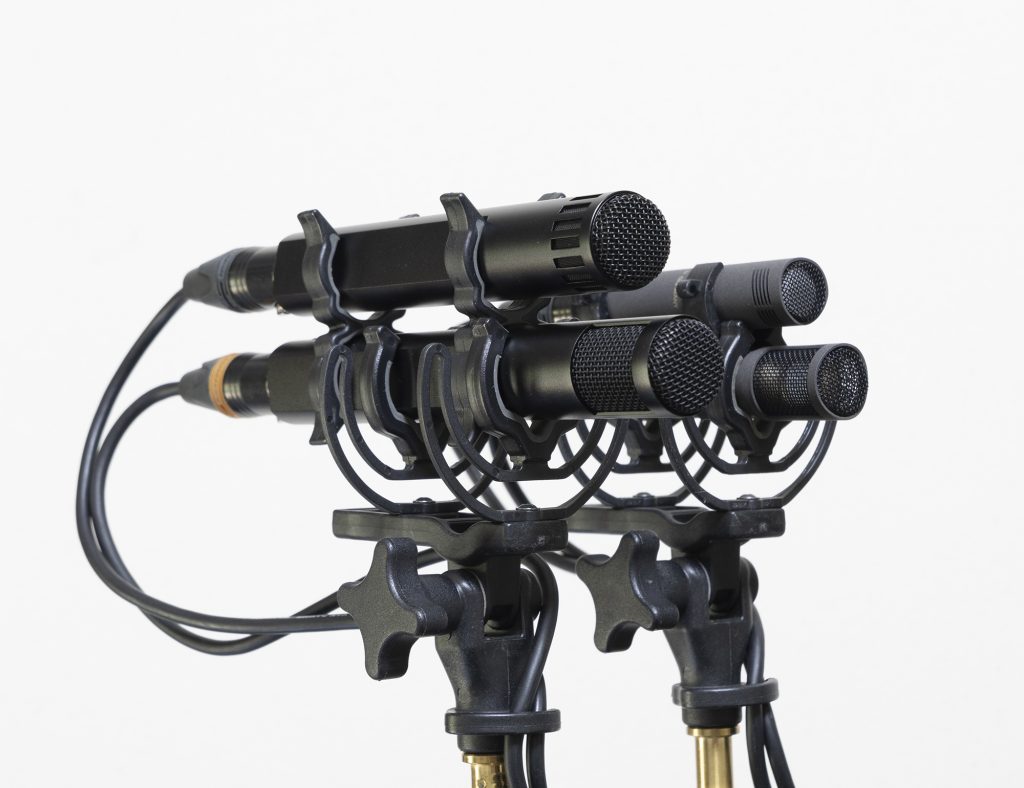
This is turning into something of a marathon, with the latest installment of the Sennheiser MKH 8030 fig 8 mic tests comprising a comparison with its older MKH counterpart: the MKH 30. The latter was introduced back in 1987 and is still in production: quite what Sennheiser’s plans are for the mic, now that the MKH 8030 is starting to appear in retailers, I simply do not know, but some of the other earlier MKH range have dropped out of production (MKH 20 omni and MKH 40 cardioid). Whether the MKH 30 continues to be made for years or not, recordists will wonder: just how does the new fig 8 compare? As with all the MKH 8000 series mics there are the obvious physical differences of size; the new series being modular; and the earlier range having built-in switchable high-pass filters and pre-attenuation (vs this only being available via the additional MZF 8000 module – now just updated to the MZF 8000 II). And then there is the extended high-frequency response of the MKH 8000 mics. But just how different do the two fig 8 mics sound? I was certainly interested in this question, and have been receiving queries from others similarly wondering, so armed with an MKH 30 and, to allow some MS comparisons, an MKH 50 (still in production, by the way) sent by the folks at Sennheiser, I set to for some comparisons.
The sound of silence
First off to compare is the sound of the two mics recording nothing: their self-noise. Both are specified as 13dBa, but self-noise rarely sounds the same between different makes or even ranges of mics and with the known very different frequency response above 20kHz, there was every reason to suspect there might be subtle differences as, indeed, there are between the other MKH 8000 polar patterns and their older MKH counterparts. So into the airing cupboard, under duvets and towels, went the mics and off went the electricity for my usual home-brewed and very much not laboratory conditions for comparing self-noise. As for the self-noise tests in part 1 of the MKH 8030 tests, I used a 100Hz high-pass filter since it was impossible to keep out the very low frequencies.
Here are the spectrum analyzer visualizations of the noise, with gain cranked up:
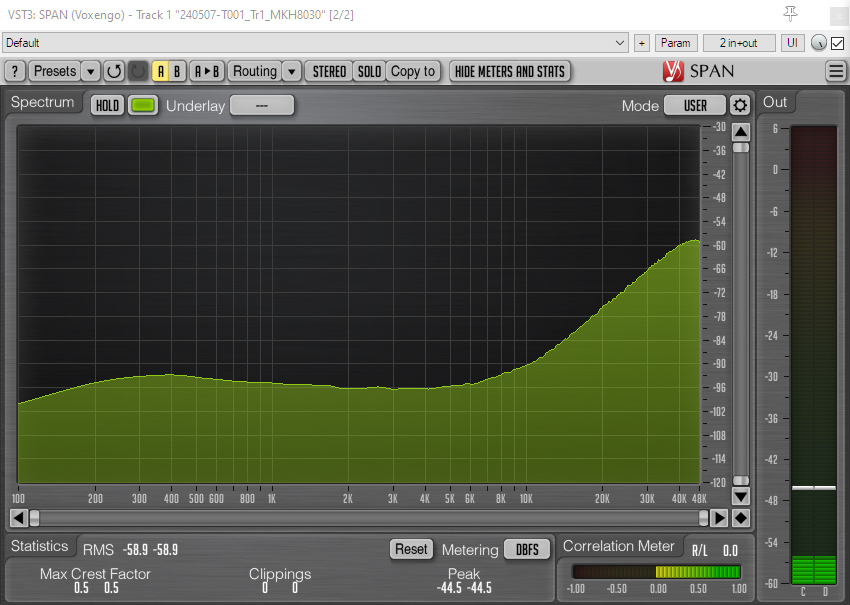
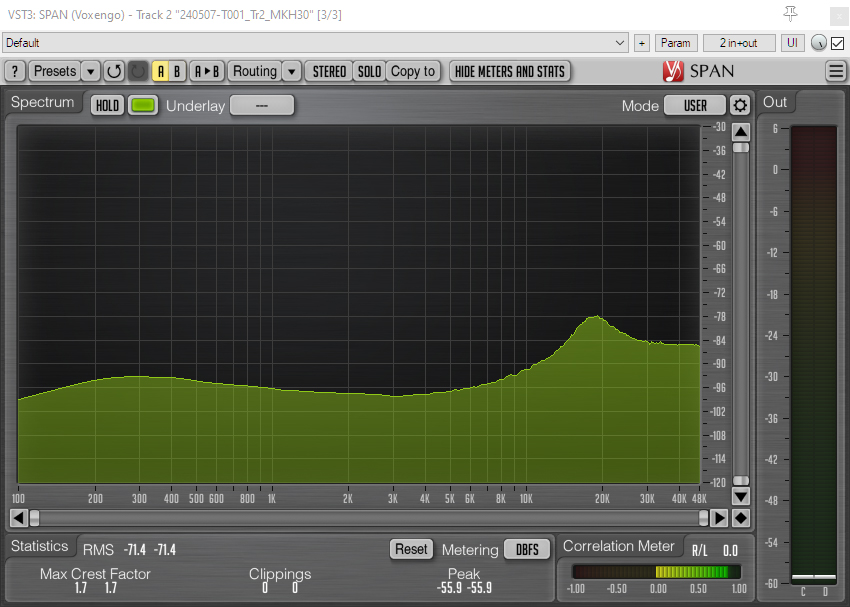
As expected, the self-noise looks wildy different, but, of course, most of this is the increased self-noise in the MKH 8030 over 20kHz (i.e. above human hearing). In the audible part of the spectrum, the two are pretty comparable, although the gentle dip between 1kHz and 6kHz is a little deeper (by a couple of dB) with the MKH 30, which translates to the self-noise of the MKH 8030 being fractionally more noticeable. But we are splitting hairs here: both mics have remarkably low-self noise for SDC fig 8s and there is nothing of concern with the new design vs the older one on this front.
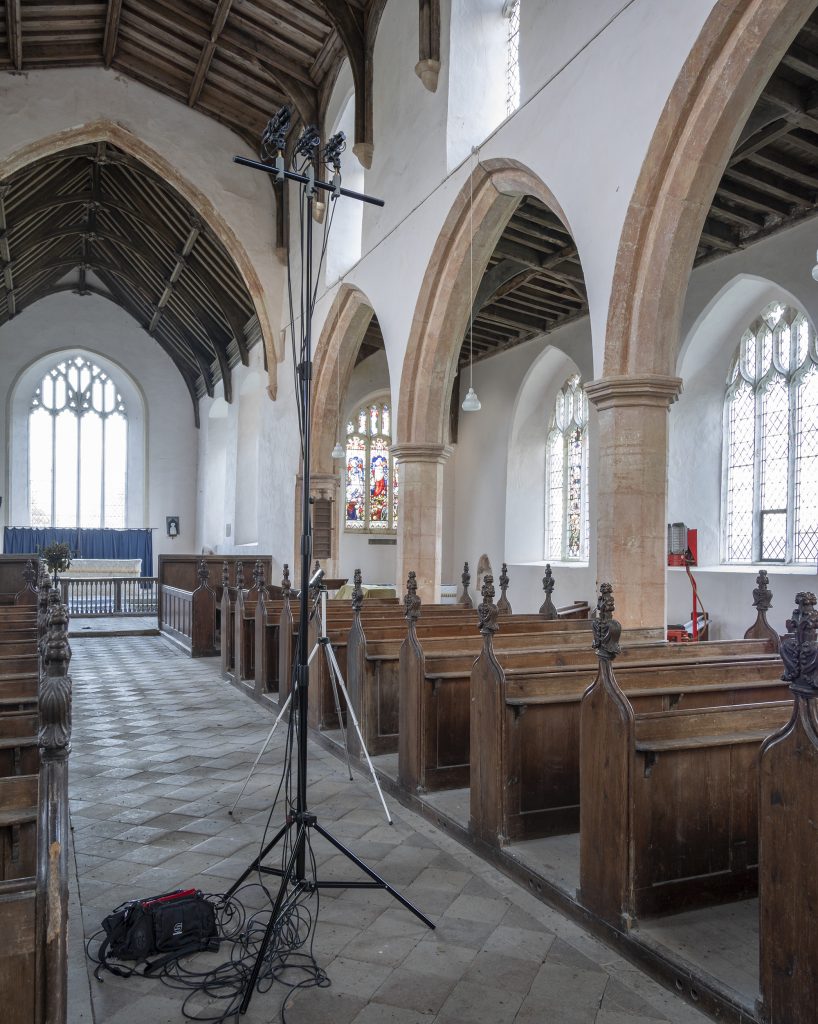
Bats in the belfry…or not
One of the distinctive features of the MKH 8000 series is, indeed, the extended frequency range. You can see this in spectrograms of many a recording where frequencies above 20kHz are present: the specs cite a 50kHz upper limit vs 20kHz for the MKH 30. Taking this to extremes, I went with Norfolk-based ecologist, Danny Cotgrove, to Guestwick Church at dusk, comparing the MKH 8050/8030 and MKH 50/30 mics: obviously an unfair comparison, but it was an interesting evening nonetheless. I was particularly impressed by seeing Danny’s Batlogger M2 in action (evidently the right tool for the job), but that’s another story. There weren’t a lot (a ‘cauldron’?) of bats in action, but just the odd one: common pipistrelles and some Myotis bats (probably Natterer’s bats), apparently. Here are a few short clips, slowed down to 25%.
The bats are much clearer in the MKH 8050/8030 MS pair than in the MKH 50/30 pair, as expected, but the self-noise of the MKH 8000 mics at such high frequencies is distracting. Obviously, to get usable audio from such quiet ultrasonic sounds requires some hiss removal, so here is a very quick and dirty example using RX De-noise:
And here are the spectrograms for the two fig 8 mics:
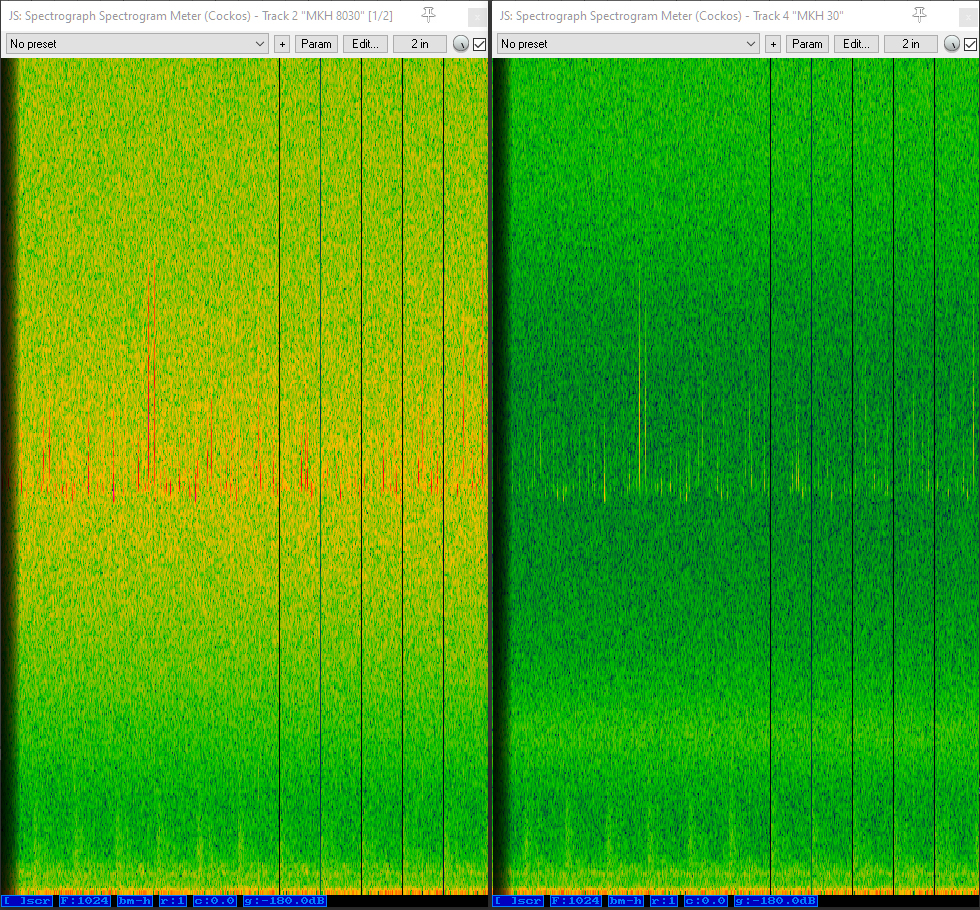
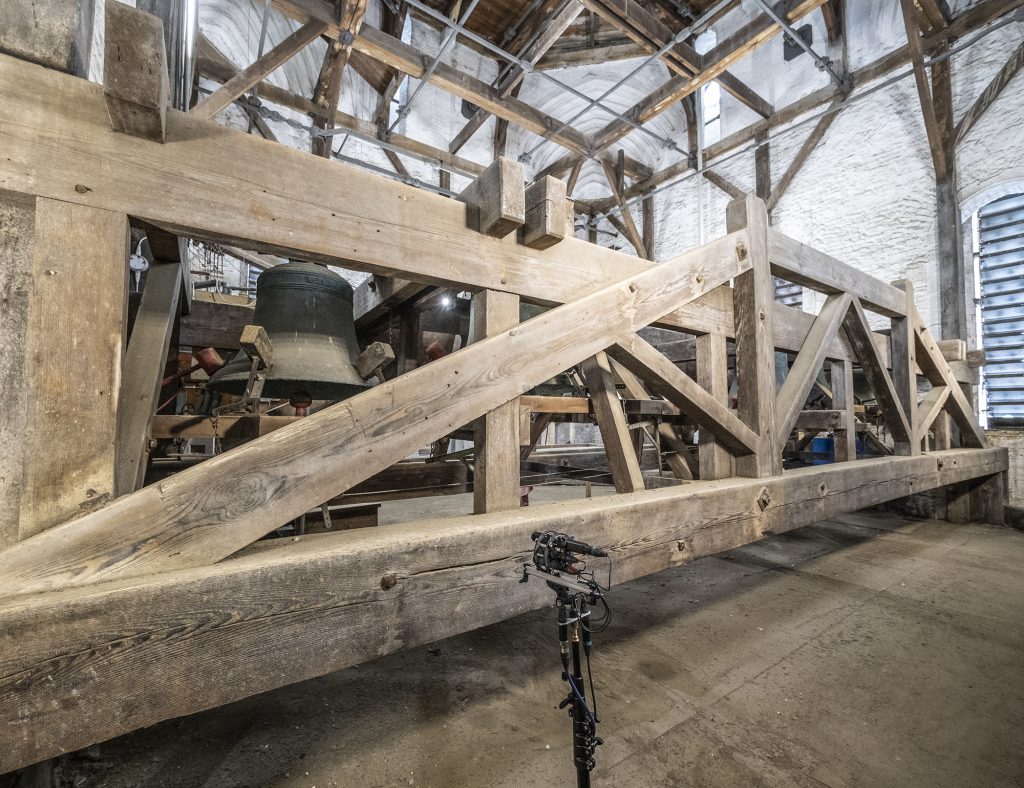
At face value, the bat recording example might seem as if it leads to a dismal conclusion: i.e. the MKH 8030 has much higher frequency capability than the MKH 30, but the price of raised self-noise is too high to pay. But bear with me. With a touch of irony, I headed off to the cathedral belfry, not for more bats but for a (very) healthy signal of an audible sound with extended high frequency overtones: the bells, the bells! The spectrograms show that the sound extends above 48kHz, but of more use are the sound files.
Here we have the original unmodified (mono) recordings with the individual fig 8 mics:
And here we have the same two clips slowed down to 25% (just as I did for the bat recordings), as if playing around for sound design: reassuringly there is no distracting self-noise – a consequence of a healthy sound signal – and there is no need for noise removal.
So, yes, the MKH 8030, like its siblings in the same series, has extended high-frequency that can be useful and is something that the MKH 30 and its siblings don’t offer to this degree, but, with quiet signals, it will need much care and some de-noising. Whether or not this capability matters to the sound recordist is a different thing altogether: for many, if not most, a frequency response over 20kHz is simply not needed.
It’s all about that bass
Down at the other end of the frequency spectrum the specs for the two fig 8 suggest that the MKH 8030 goes a bit lower: the frequency response graph of the MKH 30 cuts off at 40Hz, though, so it is hard to tell from this how it compares with the MKH 8030 below this. Turning to my quick and dirty low-frequency source, I stuck the mics by the exhaust pipe of an idling car engine, and this showed that the MKH 8030 does indeed have more low end that its older counterpart.
Here are the sound files:
And here are the spectrum analyzer visualizations of the exhaust recordings:

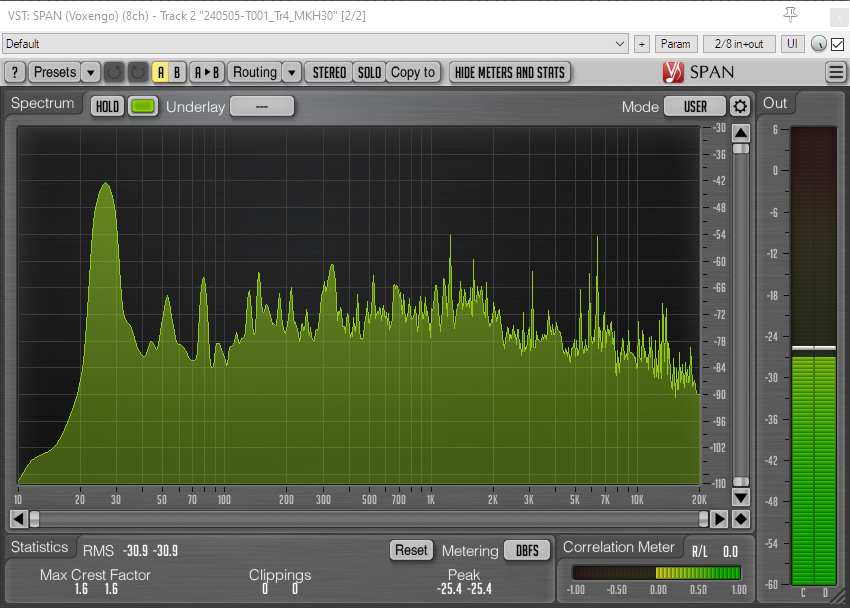
The most distinct feature is the level of the fundamental (26.4Hz), which is c.4.5dB louder with the MKH 8030 vs the MKH 30. This is not to say that the MKH 8030 oddly emphasizes bass: as we saw in part 1 of the MKH 8030 tests, similar tests with another car exhaust saw the MKH 8040 measure 9dB more than the MKH 8030 at the 22.5Hz fundamental. Now, just as with the high-frequency extended range, some may not find the increased low end of the MKH 8030 vs the MKH 30 especially useful, but I suspect many more will, for music recording and bass-heavy ambiences and sound effects amongst other things. I’m certainly one of the ones who is glad to have a bit better low-frequency performance. And if you don’t want it, its easy to roll off with a high-pass filter in your mixer/recorder or via the MZF 8000 ii filter module.
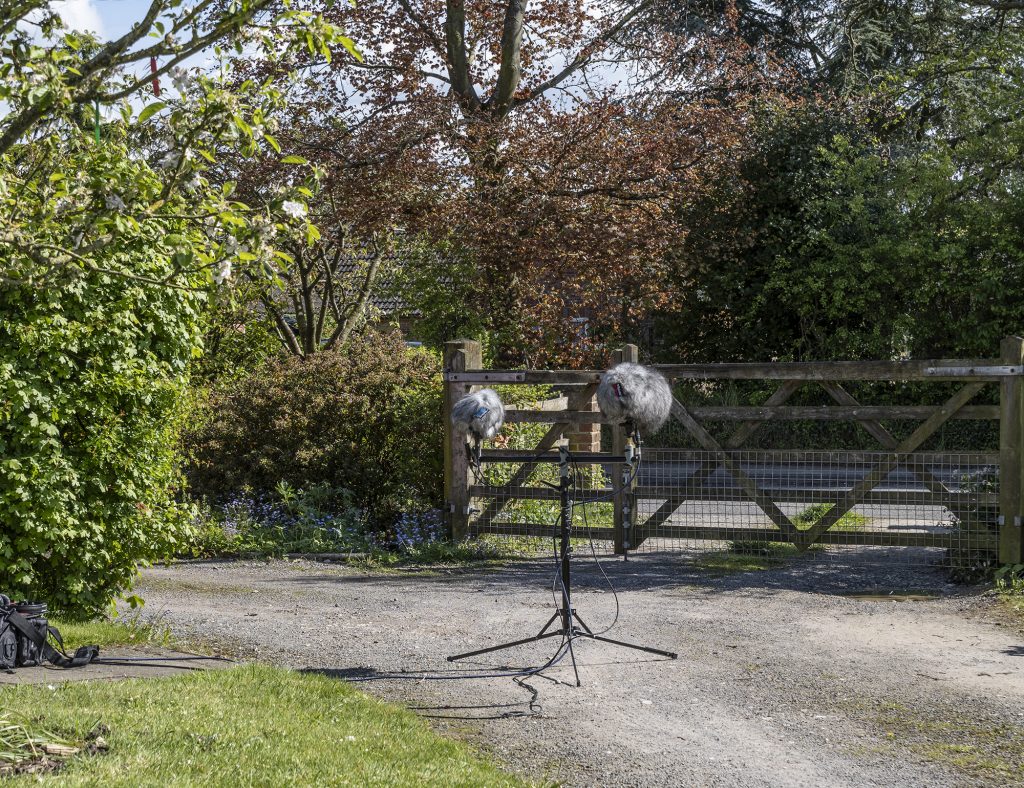
In the field
The robust and, above all, humidity-resistant nature of the RF-based MKH mics has made them favourites for recording in the field, be that production sound or field recording, so I moved on to record some ambiences. As usual, nothing very adventurous: you don’t need a long-haul flight and a rare species to test a mic in the field (though doubtless a rain forest would provide some nice humidity), so, as I have done so many times before, I ventured a few yards further down my drive from the car exhaust test to record the sounds of early May in my quiet Norfolk village street. Sorry if you are getting bored of listening to my village street, but cheer yourself up with the thought of how environmentally friendly this is! And it always gives a good mixture of sounds: birdsong, passing cars, the odd sound of a distant shotgun (or is it a bird-scarer?), and whatever the neighbours are up to: a bit of landscape gardening this time.
There are two sets of recordings: first off, we have the two fig 8s together, rigged with back-to-back clips in a single Rycote Cyclone, and facing the road;
Then, second, we have two separate windshields each containing a mid-side pair with each fig 8 paired with its super-cardioid sibling. Obviously the different qualities of the two mid-mics comes into play, but as an MS side mic is how most field recordists use the MKH 30 and how most will use the new MKH 8030.
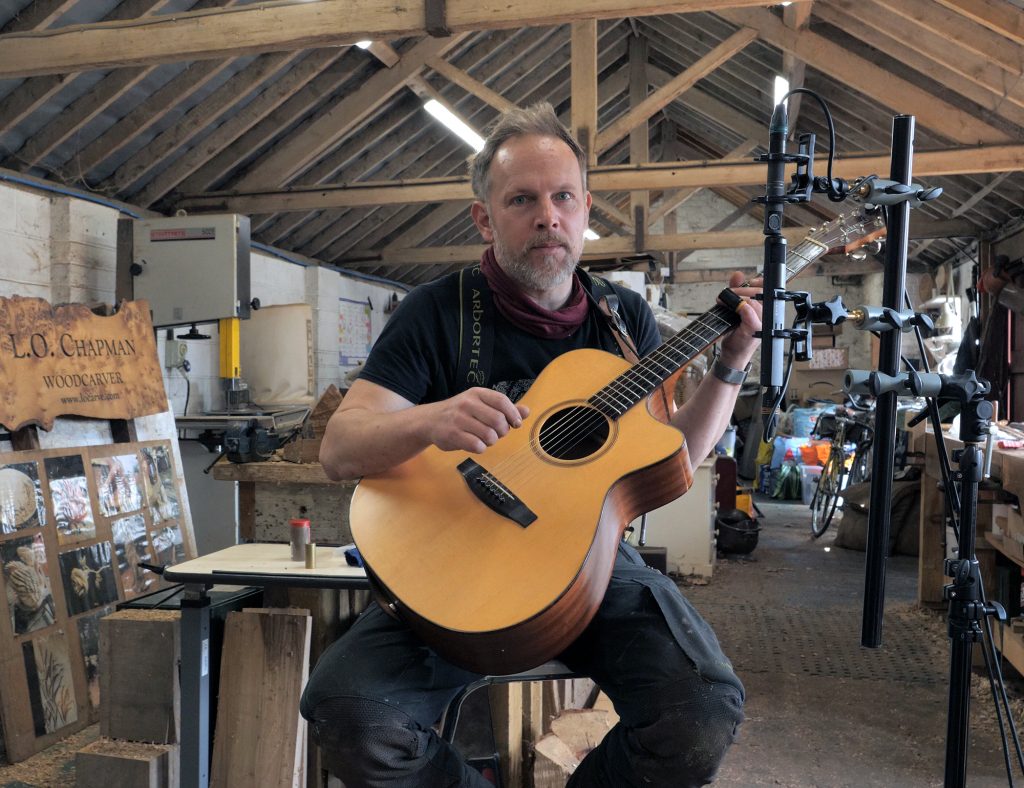
Down in the workshop
Moving inside again for some musical tests, I tootled down the back lanes to the workshop of woodcarver and musician Luke Chapman. Luke was happy to put down his chainsaw (well, actually he was re-spraying his Land Rover chassis when I arrived) to oblige again with some guitar playing, and the sets of recordings comprise mono recordings with the two fig 8s (which I rigged end-to-end, pointing at the twelfth fret from about 600mm/2ft away) and then mid-side recordings with the MKH 8050/8030 and MKH 50/30 pairs, a little further back (to get a bit more ambience into the recording: you can really hear the rooks outside trying to join in). There has been no processing (compression, equalization, addition of reverb etc.) of the recorded sound. The mono recordings with just the two fig 8 mics aimed towards the sound source are perhaps the most informative, although, again, the MS pairs show how the two mics sound with one of their respective siblings as the mid mic. I’m sure some will hear (or at least imagine they hear!) significant differences, but, to me at least, the two fig 8s sound remarkably similar.
Here are the two recordings of the fig 8s on their own:
And here are the recordings of the two MS pairs:
And here’s a video of the guitar test recordings – both the mono comparisons of the two fig 8s, and then the two mid-side rigs – cutting from one mic/pair to the other.
Conclusions
These few tests just skim the surface of comparisons between the MKH 30 and MKH 8030. With the other polar patterns of the two MKH ranges of mics, there have been recordists who prefer one to the other: or one vs its equivalent for a particular purpose. Evidently there are some subtle nuances and preferences, with these varying in relation to a wide gamut of sound sources, that are beyond the scope of the necessarily simple tests here: such discerning recordists will want to get both mics in their hands to compare them in their typical uses. But with that caveat, my experience of using the two mics is that the MKH 8030 occupies a similar position to the other MKH 8000 mics compared to their equivalents in the older MKH series: as such it lives up to the well-deserved reputation of the MKH 30. Just as with the other MKH 8000 series mics, it doesn’t render the older MKH fig 8 redundant: far from it. If you need a very low noise SDC fig 8 with demonstrable ability in high humidity and that sounds top class, then both of the Sennheiser fig 8s are likely to be at the top of your list: if you also want a very small SDC and one where there is a full range of mics in the same series currently in production, then, obviously, your choice out of the two will be the MKH 8030.

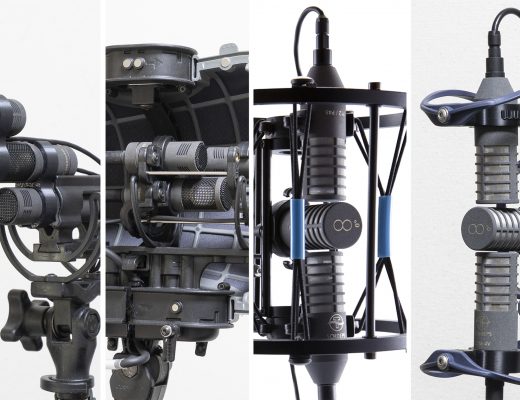


No Comments